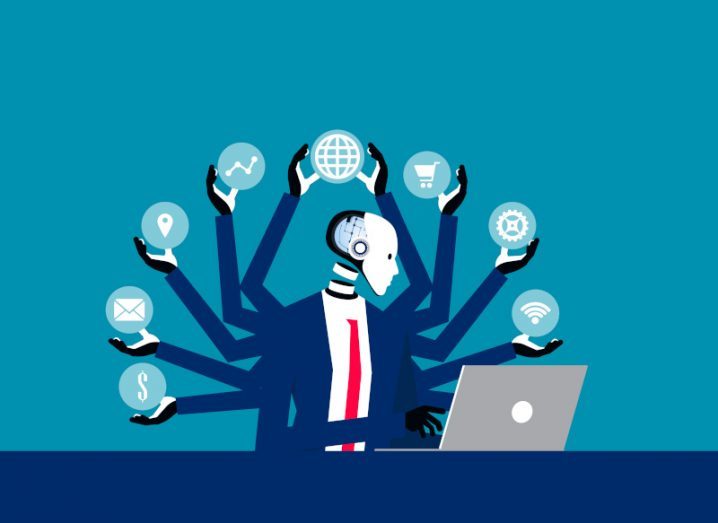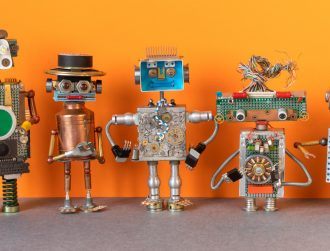
Image: © zenzen/Stock.adobe.com
William Fry’s Barry Scannell discusses the ways that AI regulations affect the workplace moving forward.
In an age where technological advancements drive our daily lives, artificial intelligence (AI) stands at the forefront of this evolution, promising transformations that could redefine the very fabric of our work culture. Recent revelations from Goldman Sachs bring to light the imminent impact of generative AI systems, such as ChatGPT, on the global employment landscape.
According to Goldman Sachs, the integration of generative AI into the work sphere over the next decade might bolster global GDP by an astonishing 7pc annually. The US, with its robust technological infrastructure, could witness a surge in labour productivity growth by almost 1.5pc each year. This puts the global AI growth bonus at a staggering 1.4pc, translating to nearly $7trn in added global GDP over 10 years.
While AI’s reach might envelop two-thirds of jobs in the US and Europe, it’s crucial to note that most individuals will retain their jobs, with less than 50pc of their workload being automated. However, approximately 7pc of US workers might face a future where generative AI systems could overshadow over half of their tasks. With AI poised to automate nearly a fifth of work, translating to 300m full-time jobs in leading economies, the question arises: Are we ready for this seismic shift?
The Changing Work Paradigm
Recent research from OpenAI underlines that generative AI could undertake at least 10pc of tasks for a whopping 80pc of the US workforce. A closer look reveals that desk-bound jobs face the most substantial impact, indicating a considerable reconfiguration of conventional office roles.
Yet, history has shown that technology often brings more opportunities than it eliminates. A study by economist David Autor and team in 2022 underscores that 60pc of current job roles didn’t exist in 1940. A staggering 85pc of employment growth over the past eight decades owes its genesis to technology-driven new roles. Therefore, while 7pc of workers might lose their jobs due to AI, the potential for new job opportunities remains significant.
The AI Act
The AI Act refers to a proposed regulatory framework for artificial intelligence in the European Union. Its primary objective is to ensure the safe and ethical development and deployment of AI technologies while fostering innovation. The AI Act classifies AI systems based on their potential risks, with stricter requirements and oversight for ‘high-risk’ systems. It emphasises transparency, accountability, and user rights while aiming to create a single market for AI products and services in the EU.
The rise of artificial intelligence in the modern workplace is accompanied by both the potential of efficiency enhancements and concerns surrounding job security and ethics. The AI Act has been crafted to regulate and ensure that the introduction of high-risk AI systems in employment scenarios is conducted responsibly.
The AI Act requires a consultation with workers’ representatives before deploying high-risk AI systems, underscores the importance of collaboration and open dialogue. Such consultations serve not only to foster trust between employees and management, but also to ensure that any AI system introduced aligns with the genuine needs and concerns of the workforce. This participatory approach can also help to mitigate potential apprehensions and resistance from employees.
Furthermore, the requirement that employees be informed of their exposure to high-risk AI systems promotes transparency. This not only ensures that employees are not kept in the dark about significant AI implementations that might impact their roles but also grants them an opportunity to prepare for the changes the AI might introduce. Being informed allows employees to consider upskilling or reskilling, to provide feedback, and to better understand the purpose and limitations of the AI they are interacting with.
The AI Act’s inclusive definition of high-risk AI systems in the realm of employment covers a significant range of AI applications. AI’s increasing role in recruitment, for instance, can lead to potential biases or the unfair elimination of candidates. The Act’s provisions ensure such systems operate transparently and fairly. Meanwhile, AI systems that have a significant influence on decisions related to promotions, task allocations, or terminations can have profound impacts on an employee’s professional journey. By earmarking these as high risk, the Act highlights the need for robust oversight and validation. Additionally, with AI’s role in evaluating employee performance, concerns about privacy and excessive surveillance emerge. The Act stresses the ethical deployment of such monitoring systems.
The AI Act reflects a visionary approach to AI’s integration into employment contexts. By emphasising transparency, active participation, and rigorous oversight, it endeavours to find a harmonious balance between harnessing AI’s potential benefits and safeguarding workers’ rights and interests. As the landscape of work evolves, the guidelines set forth by the AI Act promise a future where technological progress aligns seamlessly with human welfare.
Steering Towards the Future
The omnipresence of generative AI systems, especially LLMs (large language models) like GPT-4, promises to redefine industries. While information processing might be significantly influenced, sectors like manufacturing, agriculture, and mining could remain relatively untouched. Nevertheless, with AI’s capabilities continuously evolving, businesses and individuals must remain agile and adaptable.
The challenge for policymakers is evident: regulating and harnessing the potential of general-purpose AI. The EU’s struggle in defining and overseeing AI showcases the complexities involved. Despite the vast potential of AI, external factors such as societal norms, economic conditions, and regulations will play a crucial role in determining AI’s real-world impact.
The era of AI-induced work transformation is upon us. Businesses that fail to acknowledge and integrate AI strategies risk being sidelined in this rapid evolution. While the future might seem daunting, the potential for growth, efficiency, and new opportunities remains boundless. As we tread this path, it’s imperative to remain informed, agile, and prepared for the challenges and opportunities AI presents.
Barry Scannell is a senior solicitor and consultant in William Fry’s technology department specialising in artificial intelligence, copyright, IP, technology law and data protection.
10 things you need to know direct to your inbox every weekday. Sign up for the Daily Brief, Silicon Republic’s digest of essential sci-tech news.






